Strength Deterioration Model of Soft Rock Considering Mesoscopic Bonding–Expansion Coupling Mechanism under Freeze–Thaw Cycles
Abstract
:1. Introduction
2. Content and Method
2.1. Bonding–Expansion Coupling Mechanism of Mesoscopic Clusters in Soft Rocks under F-T Cycles
- (1)
- (2)
- The bonds can be damaged, and the pores are able to carry liquid water and provide the initial space for freezing swelling;
- (3)
- The pore volume increases after damage occurs and more pore water will enter the interior of the soft rock under water-rich conditions.
2.2. Soft Rock Strength Deterioration Model Based on Bonding–Expansion Coupling Mechanism
2.3. Discrete Element Application of the F-T Strength Deterioration Model for Soft Rock
3. Results and Discussion
3.1. Parameters Determination of Soft Rock F-T Cycle Strength Deterioration Model
3.2. Strength Deterioration Model Validation and Multiscale Mechanical Analysis of Soft Rock under F-T Cycles
3.3. Discussion on the Influence of Mesoscopic Bonding–Expansion Coupling Effect in Cracked Soft Rocks
4. Conclusions
- (1)
- In this paper, a soft rock freeze–thaw cycle strength-deterioration model is proposed based on the bonding–expansion coupling mechanism, which can fully consider the correlations of multiscale damage and explain the strength decreasing and damage mode from the meso-damage cracks’ generation rate and direction;
- (2)
- The mesoscopic bonding–expansion coupling mechanism proposed in this paper can explain the multiscale damage mechanism of soft rock freeze–thaw cycling, and the corresponding strength-deterioration model has a computational error less than 10% compared with indoor tests, which can correlate macroscopic and mesoscopic damage to the special freeze–thaw damage process of jointed soft rock;
- (3)
- Although no model can replace laboratory testing in engineering design, the soft rock-strength deterioration model can provide guidance for the prevention of landslides and tunnel collapses induced by freeze–thaw cycles under water-rich conditions in cold regions, and the model can be easily extended for application on different soft rocks.
Author Contributions
Funding
Institutional Review Board Statement
Informed Consent Statement
Data Availability Statement
Conflicts of Interest
References
- Jin, D.W.; Sun, J.F.; Fu, S.L. Discussion on landslides hazard mechanism of two kinds of low angle slope in permafrost region of Qinghai-Tibet plateau. Rock Soil Mech. 2005, 26, 774–778. [Google Scholar]
- Lai, J.X.; Qiu, J.L.; Fan, H.B.; Chen, J.X.; Xie, Y.L. Freeze-proof method and test verification of a cold region tunnel employing electric heat tracing. Tunn. Undergr. Space Technol. 2016, 60, 56–65. [Google Scholar] [CrossRef]
- Liu, Q.; Huang, S.; Kang, Y.; Pan, Y. Study of unfrozen water content and frost heave model for saturated rock under low temperature. Chin. J. Rock Mech. Eng. 2016, 35, 2000–2012. [Google Scholar]
- Lyu, Z.T.; Xia, C.C.; Liu, W.P. Analytical solution of frost heaving force and stress distribution in cold region tunnels under non-axisymmetric stress and transversely isotropic frost heave of surrounding rock. Cold Reg. Sci. Technol. 2020, 178, 103117. [Google Scholar] [CrossRef]
- Wu, G.; Chen, W.; Cui, K.; Wang, P. Degradation behavior and mechanism of slate under alternating conditions of freeze-thaw and wet-dry. J. Cent. South Univ. (Sci. Technol.) 2019, 50, 1392–1402. [Google Scholar] [CrossRef]
- Zhao, X.; Zhang, H.W.; Lai, H.P.; Yang, X.H.; Wang, X.Y.; Zhao, X.L. Temperature field characteristics and influencing factors on frost depth of a highway tunnel in a cold region. Cold Reg. Sci. Technol. 2020, 179, 103141. [Google Scholar] [CrossRef]
- Liu, Z.; Zhou, C.; Li, B.; Zhang, L.; Liang, Y. Effects of grain dissolution-diffusion sliding and hydro-mechanical interaction on the creep deformation of soft rocks. Acta Geotech. 2020, 15, 1219–1229. [Google Scholar] [CrossRef]
- Ballantyne, C.K.; Sandeman, G.E.; Stone, J.O.; Wilson, P. Rock-slope failure following Late Pleistocene deglaciation on tectonically stable mountainous terrain. Quat. Sci. Rev. 2014, 86, 144–157. [Google Scholar] [CrossRef]
- Chen, Y.L.; Ni, J.; Jiang, L.H.; Liu, M.L.; Wang, P.; Azzam, R. Experimental study on mechanical properties of granite after freeze-thaw cycling. Environ. Earth Sci. 2014, 71, 3349–3354. [Google Scholar] [CrossRef]
- Park, K.; Kim, K.; Lee, K.; Kim, D. Analysis of Effects of Rock Physical Properties Changes from Freeze-Thaw Weathering in Ny-angstrom lesund Region: Part 1-Experimental Study. Appl. Sci.-Basel 2020, 10, 1707. [Google Scholar] [CrossRef]
- Yavuz, H.; Altindag, R.; Sarac, S.; Ugur, I.; Sengun, N. Estimating the index properties of deteriorated carbonate rocks due to freeze-thaw and thermal shock weathering. Int. J. Rock Mech. Min. Sci. 2006, 43, 767–775. [Google Scholar] [CrossRef]
- Wang, Y.; Feng, W.K.; Wang, H.J.; Li, C.H.; Hou, Z.Q. Rock bridge fracturing characteristics in granite induced by freeze-thaw and uniaxial deformation revealed by AE monitoring and post-test CT scanning. Cold Reg. Sci. Technol. 2020, 177, 103115. [Google Scholar] [CrossRef]
- Prick, A. Dilatometrical behaviour of porous calcareous rock samples subjected to freeze–thaw cycles. CATENA 1995, 25, 7–20. [Google Scholar] [CrossRef]
- Shen, Y.J.; Wang, Y.Z.; Wei, X.; Jia, H.L.; Yan, R.X. Investigation on meso-debonding process of the sandstone-concrete interface induced by freeze-thaw cycles using NMR technology. Constr. Build. Mater. 2020, 252, 118962. [Google Scholar] [CrossRef]
- Kang, Y.S.; Hou, C.C.; Liu, B.; Liu, Q.S.; Sang, H.M.; Tian, Y.C. Frost Deformation and a Quasi-Elastic-Plastic-Creep Constitutive Model for Isotropic Freezing Rock. Int. J. Geomech. 2020, 20, 4020119. [Google Scholar] [CrossRef]
- Zhou, C.; Su, D.; Qiu, X.; Yang, X.; Liu, Z. Experimental study of cracked soft rock with hydro—Mechanical coupling effect. Acta Sci. Nat. Univ. Sunyatseni 2019, 58, 35–44. [Google Scholar]
- Drotz, S.H.; Tilston, E.L.; Sparrman, T.; Schleucher, J.; Nilsson, M.; Oquist, M.G. Contributions of matric and osmotic potentials to the unfrozen water content of frozen soils. Geoderma 2009, 148, 392–398. [Google Scholar] [CrossRef]
- Zhao, B.; Liu, D.; Li, Z.; Huang, W.; Dong, Q. Mechanical Behavior of Shale Rock under Uniaxial Cyclic Loading and Unloading Condition. Adv. Civ. Eng. 2018, 2018, 9750480. [Google Scholar] [CrossRef]
- Zhang, M.Y.; Zhang, X.Y.; Lu, J.G.; Pei, W.S.; Wang, C. Analysis of volumetric unfrozen water contents in freezing soils. Exp. Heat Transf. 2019, 32, 426–438. [Google Scholar] [CrossRef]
- Zhou, X.H.; Zhou, J.; Kinzelbach, W.; Stauffer, F. Simultaneous measurement of unfrozen water content and ice content in frozen soil using gamma ray attenuation and TDR. Water Resour. Res. 2014, 50, 9630–9655. [Google Scholar] [CrossRef]
- Anderson, R.S.; Anderson, S.P.; Tucker, G.E. Rock damage and regolith transport by frost: An example of climate modulation of the geomorphology of the critical zone. Earth Surf. Processes Landf. 2013, 38, 299–316. [Google Scholar] [CrossRef]
- Chen, Y.L.; Wu, P.; Yu, Q.; Xu, G. Effects of Freezing and Thawing Cycle on Mechanical Properties and Stability of Soft Rock Slope. Adv. Mater. Sci. Eng. 2017, 2017, 3173659. [Google Scholar] [CrossRef]
- Kolay, E. Modeling the effect of freezing and thawing for sedimentary rocks. Environ. Earth Sci. 2016, 75, 210. [Google Scholar] [CrossRef]
- Luo, X.D.; Jiang, N.; Fan, X.Y.; Mei, N.F.; Luo, H. Effects of freeze-thaw on the determination and application of parameters of slope rock mass in cold regions. Cold Reg. Sci. Technol. 2015, 110, 32–37. [Google Scholar] [CrossRef]
- Mu, J.Q.; Pei, X.J.; Huang, R.Q.; Rengers, N.; Zou, X.Q. Degradation characteristics of shear strength of joints in three rock types due to cyclic freezing and thawing. Cold Reg. Sci. Technol. 2017, 138, 91–97. [Google Scholar] [CrossRef]
- Li, J.; Kaunda, R.B.; Zhu, L.; Zhou, K.; Gao, F. Experimental Study of the Pore Structure Deterioration of Sandstones under Freeze-Thaw Cycles and Chemical Erosion. Adv. Civ. Eng. 2019, 2019, 9687843. [Google Scholar] [CrossRef]
- Lei, D.; Lin, H.; Chen, Y.; Cao, R.; Wen, Z. Effect of Cyclic Freezing-Thawing on the Shear Mechanical Characteristics of Nonpersistent Joints. Adv. Mater. Sci. Eng. 2019, 2019, 9867681. [Google Scholar] [CrossRef]
- Ma, Q.; Ma, D.; Yao, Z. Influence of freeze-thaw cycles on dynamic compressive strength and energy distribution of soft rock specimen. Cold Reg. Sci. Technol. 2018, 153, 10–17. [Google Scholar] [CrossRef]
- Li, J.; Zhou, K.; Liu, W.; Zhang, Y. Analysis of the effect of freeze-thaw cycles on the degradation of mechanical parameters and slope stability. Bull. Eng. Geol. Environ. 2018, 77, 573–580. [Google Scholar] [CrossRef]
- Qiao, G.; Wang, Y.; Chu, F.; Yang, X. Failure mechanism of slope rock mass due to freeze-thaw weathering. J. Eng. Geol. 2015, 23, 469–476. [Google Scholar]
- Lin, H.; Lei, D.; Zhang, C.; Wang, Y.; Zhao, Y. Deterioration of non-persistent rock joints: A focus on impact of freeze-thaw cycles. Int. J. Rock Mech. Min. Sci. 2020, 135, 104515. [Google Scholar] [CrossRef]
- Ling, X.Z.; Zhang, F.; Li, Q.L.; An, L.S.; Wang, J.H. Dynamic shear modulus and damping ratio of frozen compacted sand subjected to freeze-thaw cycle under multi-stage cyclic loading. Soil Dyn. Earthq. Eng. 2015, 76, 111–121. [Google Scholar] [CrossRef]
- Bost, M.; Pouya, A. Stress generated by the freeze-thaw process in open cracks of rock walls: Empirical model for tight limestone. Bull. Eng. Geol. Environ. 2017, 76, 1491–1505. [Google Scholar] [CrossRef]
- Chen, S.; Kong, L.; Xu, G. An effective way to estimate the Poisson’s ratio of silty clay in seasonal frozen regions. Cold Reg. Sci. Technol. 2018, 154, 74–84. [Google Scholar] [CrossRef]
- Zhang, H.; Xie, X.; Peng, C.; Yang, G.; Ye, W.; Sheng, Y. Constitutive model for damage of freeze-thaw rock under three-dimensional stress. Chin. J. Geotech. Eng. 2017, 39, 1444–1452. [Google Scholar]
- Zhou, Z.; Ma, W.; Zhang, S.; Mu, Y.; Li, G. Effect of freeze-thaw cycles in mechanical behaviors of frozen loess. Cold Reg. Sci. Technol. 2018, 146, 9–18. [Google Scholar] [CrossRef]
- Ji, W.D.; Kang, Y.S.; An, X.Y.; Zhao, Y. Simulation on freeze-thaw action in multi-cracks in rock mass. In Proceedings of the 4th International Conference on Intelligent System and Applied Material (GSAM), Taiyuan, China, 23–24 August 2014; p. 426. [Google Scholar]
- Xu, S.; Li, N.; Xu, G.; Wang, X.; Tian, Y.; Yuan, K.; Wang, L. Thermal transfer and heat balance of saturated rock under freezing-thawing environment. Chin. J. Rock Mech. Eng. 2016, 35, 2225–2236. [Google Scholar]
- Huang, S.-B.; Liu, Q.-S.; Cheng, A.-P.; Liu, Y.-Z. A coupled hydro-thermal model of fractured rock mass under low temperature and its numerical analysis. Rock Soil Mech. 2018, 39, 735–744. [Google Scholar] [CrossRef]
- Christ, M.; Kim, Y.C. Experimental study on the physical-mechanical properties of frozen silt. Ksce J. Civ. Eng. 2009, 13, 317–324. [Google Scholar] [CrossRef]
- Sparrman, T.; Oquist, M.; Klemedtsson, L.; Schleucher, J.; Nilsson, M. Quantifying unfrozen water in frozen soil by high-field H-2 NMR. Environ. Sci. Technol. 2004, 38, 5420–5425. [Google Scholar] [CrossRef]
- Wang, D.Y.; Zhu, Y.L.; Ma, W.; Niu, Y.H. Application of ultrasonic technology for physical-mechanical properties of frozen soils. Cold Reg. Sci. Technol. 2006, 44, 12–19. [Google Scholar] [CrossRef]
- Weng, L.; Wu, Z.J.; Taheri, A.; Liu, Q.S.; Lu, H. Deterioration of dynamic mechanical properties of granite due to freeze-thaw weathering: Considering the effects of moisture conditions. Cold Reg. Sci. Technol. 2020, 176, 103092. [Google Scholar] [CrossRef]
- Zhou, X.P.; Li, C.Q.; Zhou, L.S. The effect of microstructural evolution on the permeability of sandstone under freeze-thaw cycles. Cold Reg. Sci. Technol. 2020, 177, 103119. [Google Scholar] [CrossRef]
- Huimei, Z.; Gengshe, Y. Damage mechanical characteristics of rock under freeze-thaw and load coupling. Eng. Mech. 2011, 28, 161–165. [Google Scholar]
- Zhang, H.; Meng, X.; Peng, C.; Yang, G.; Ye, W.; Shen, Y.; Liu, H. Rock damage constitutive model based on residual intensity characteristics under freeze-thaw and load. J. China Coal Soc. 2019, 44, 3404–3411. [Google Scholar]
- Chen, Y.; Lin, H.; Wang, Y.; Zhao, Y. Damage Statistical Empirical Model for Fractured Rock under Freezing-Thawing Cycle and Loading. Geofluids 2020, 2020, 8842471. [Google Scholar] [CrossRef]
- Huimei, Z.; Gengshe, Y. Research on damage model of rock under coupling action of freeze-thaw and load. Chin. J. Rock Mech. Eng. 2010, 29, 471–476. [Google Scholar]
- Chen, S.; Qiao, C.; Ye, Q.; Ji, S. Compositedamage model of jointed rock mass under freezing and thawing load. J. Harbin Inst. Technol. 2019, 51, 100–108. [Google Scholar]
- Liu, Y.; Liu, E.; Yin, Z. Constitutive model for tailing soils subjected to freeze-thaw cycles based on meso-mechanics and homogenization theory. Acta Geotech. 2020, 15, 2433–2450. [Google Scholar] [CrossRef]
- Zhu, T.; Chen, J.; Huang, D.; Luo, Y.; Li, Y.; Xu, L. A DEM-Based Approach for Modeling the Damage of Rock Under Freeze-Thaw Cycles. Rock Mech. Rock Eng. 2021, 54, 2843–2858. [Google Scholar] [CrossRef]
- Li, B.; Wong, R.C.K. Quantifying structural states of soft mudrocks. J. Geophys. Res. -Solid Earth 2016, 121, 3324–3347. [Google Scholar] [CrossRef]
- Pinyol, N.M.; Vaunat, J.; Alonso, E.E. A constitutive model for soft clayey rocks that includes weathering effects. Geotechnique 2007, 57, 137–151. [Google Scholar] [CrossRef]
- Liu, Z.; Zhou, C.Y.; Li, B.T.; Lu, Y.Q.; Yang, X. A dissolution-diffusion sliding model for soft rock grains with hydro-mechanical effect. J. Rock Mech. Geotech. Eng. 2018, 10, 457–467. [Google Scholar] [CrossRef]
- Zhou, C.Y.; Ge, X.X.; Huang, W.; Li, D.X.; Liu, Z. Effects of Aqua-Dispersing Nano-Binder on Clay Conductivity at Different Temperatures. Sustainability 2019, 11, 4859. [Google Scholar] [CrossRef]
- Liu, Z.; Sun, H.; Lin, K.; Zhou, C.; Huang, W. Occurrence Regularity of Silt-Clay Minerals in Wind Eroded Deserts of Northwest China. Sustainability 2021, 13, 2998. [Google Scholar] [CrossRef]
- Xia, C.; Liu, Z.; Zhou, C. Burger’s Bonded Model for Distinct Element Simulation of the Multi-Factor Full Creep Process of Soft Rock. J. Mar. Sci. Eng. 2021, 9, 945. [Google Scholar] [CrossRef]
- Anderson DM, T.A. Low–temperature phases of interfacial water in clay–water systems. Soil Sci Soc Am J 1971, 35, 47–54. [Google Scholar] [CrossRef]
- Li, X.P.; Qu, D.X.; Luo, Y.; Ma, R.Q.; Xu, K.; Wang, G. Damage evolution model of sandstone under coupled chemical solution and freeze-thaw process. Cold Reg. Sci. Technol. 2019, 162, 88–95. [Google Scholar] [CrossRef]
- Castro-Filgueira, U.; Alejano, L.R.; Ivars, D.M. Particle flow code simulation of intact and fissured granitic rock samples. J. Rock Mech. Geotech. Eng. 2020, 12, 960–974. [Google Scholar] [CrossRef]
- Lin, C.; Xia, C.; Liu, Z.; Zhou, C. A Comprehensive Correlation Study of Structured Soils in Coastal Area of South China about Structural Characteristics. J. Mar. Sci. Eng. 2022, 10, 508. [Google Scholar] [CrossRef]
- Cai, M.; Kaiser, P.K.; Uno, H.; Tasaka, Y.; Minami, M. Estimation of rock mass deformation modulus and strength of jointed hard rock masses using the GSI system. Int. J. Rock Mech. Min. Sci. 2004, 41, 3–19. [Google Scholar] [CrossRef]
- Wang, H.S. Mechanical Properties and Damage Law of Confined Argillaceous Dolomite under Freeze-Thaw Cycles; Guizhou University: Guiyang, China, 2021. [Google Scholar]
- Cheng, Y.; Wong, L.N.Y. A study on mechanical properties and fracturing behavior of Carrara marble with the flat-jointed model. Int. J. Numer. Anal. Methods Geomech. 2020, 44, 803–822. [Google Scholar] [CrossRef]
- Li, B.; Guo, L.; Zhang, F.-s. Macro-micro investigation of granular materials in torsional shear test. J. Cent. South Univ. 2014, 21, 2950–2961. [Google Scholar] [CrossRef]
- Liu, J.; Li, Z.; Yang, Y.; Tang, H.; Gao, J.; Shen, H. Study on the mechanical properties of sandstone nondestructive testing under the freeze-thaw cycle. J. Water Resour. Water Eng. 2019, 30, 201–209, 216. [Google Scholar]
- Gao, F.; Wang, Q.; Deng, H.; Zhang, J.; Tian, W.; Ke, B. Coupled effects of chemical environments and freeze-thaw cycles on damage characteristics of red sandstone. Bull. Eng. Geol. Environ. 2017, 76, 1481–1490. [Google Scholar] [CrossRef]
- Liu, T.; Zhang, C.; Cao, P.; Zhou, K. Freeze-thaw damage evolution of fractured rock mass using nuclear magnetic resonance technology. Cold Reg. Sci. Technol. 2020, 170, 102951. [Google Scholar] [CrossRef]
- Xudong, S.; Jinwen, B.; Feng., G.; Wang., K.; Cui., B.; Guo., J.; Yuyang., X.; Song., C. Crack propagation law at the interface of FRP wrapped coal-backfilling composite structure. Constr. Build. Mater. 2022, 344, 128229. [Google Scholar] [CrossRef]

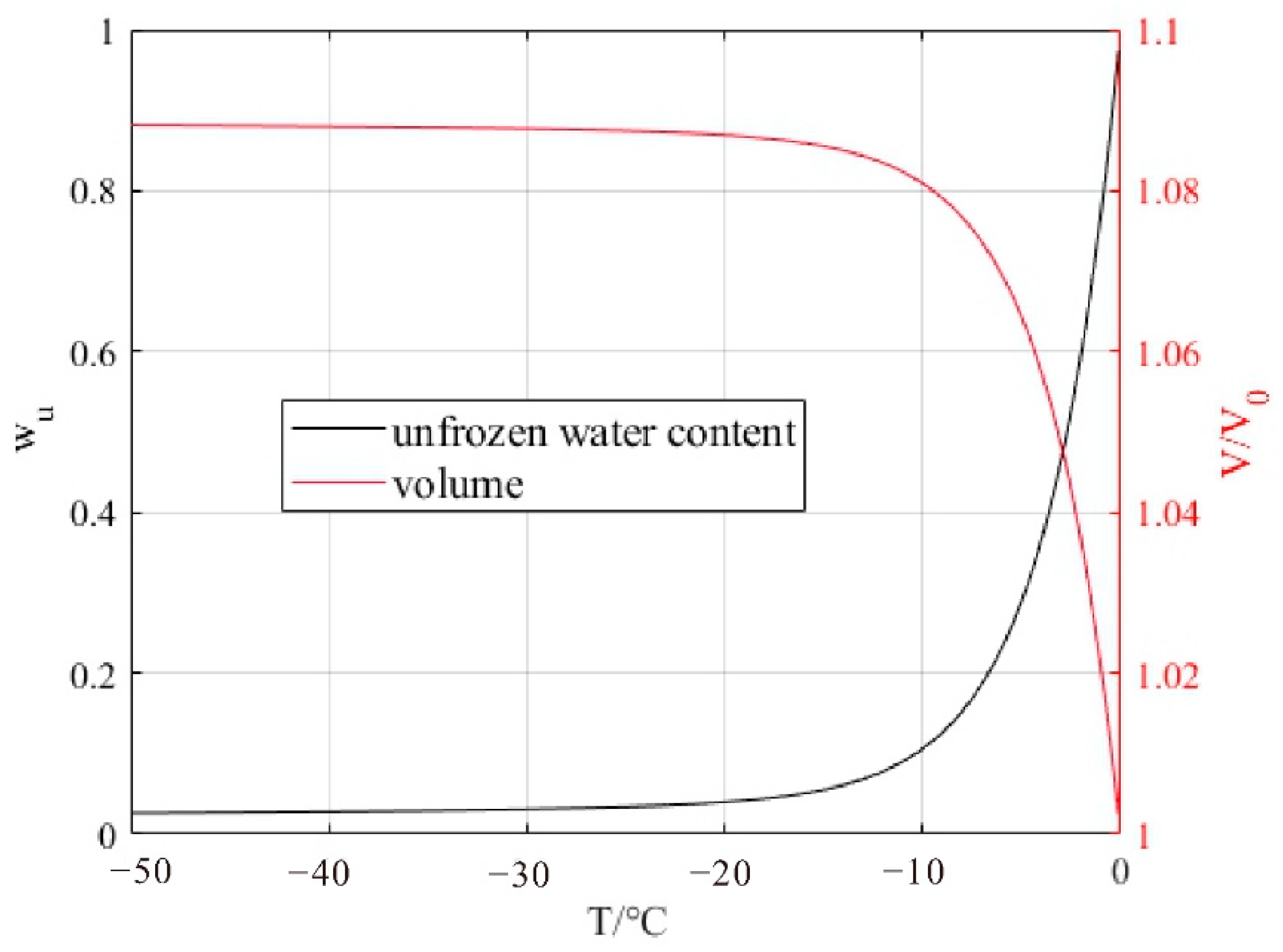


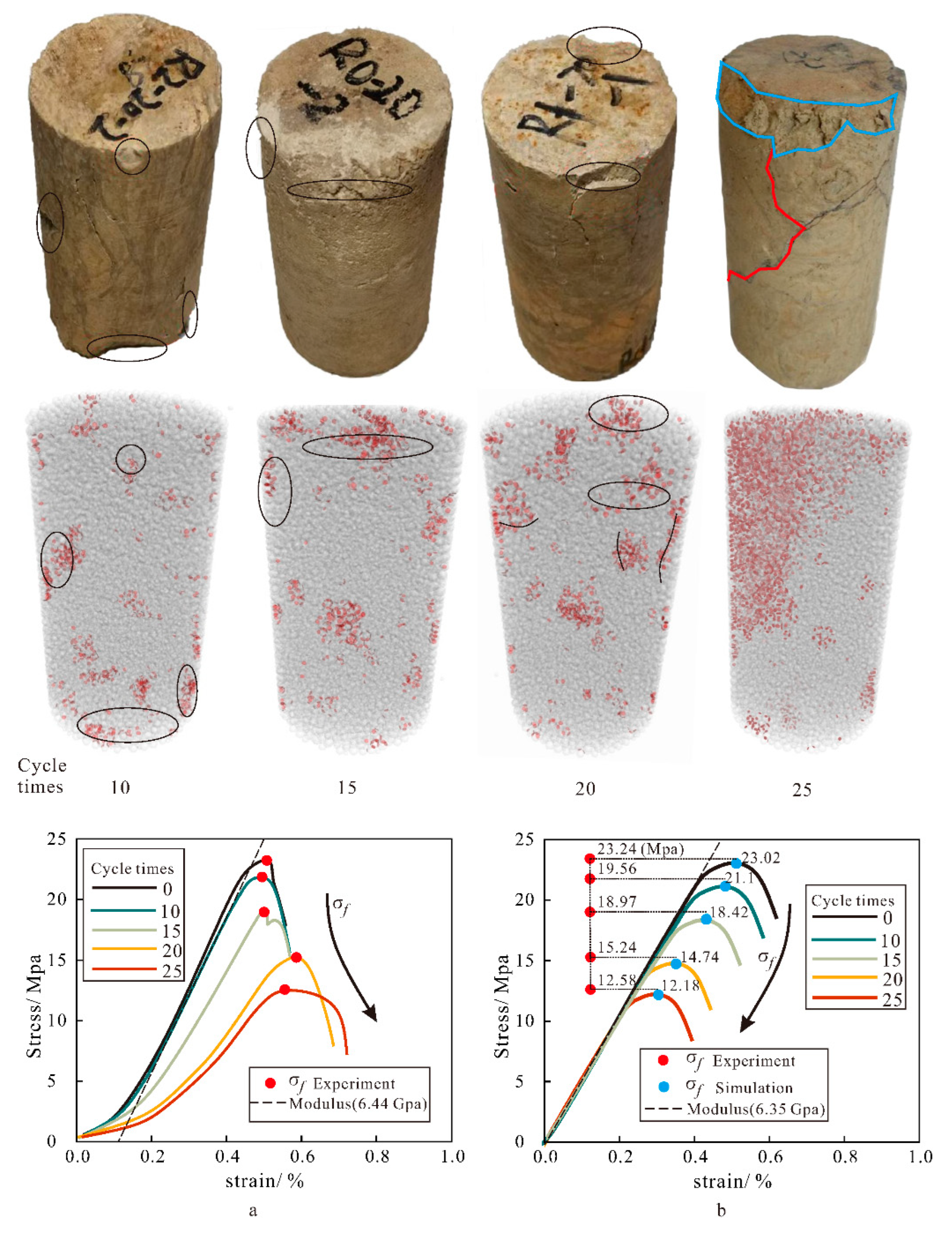
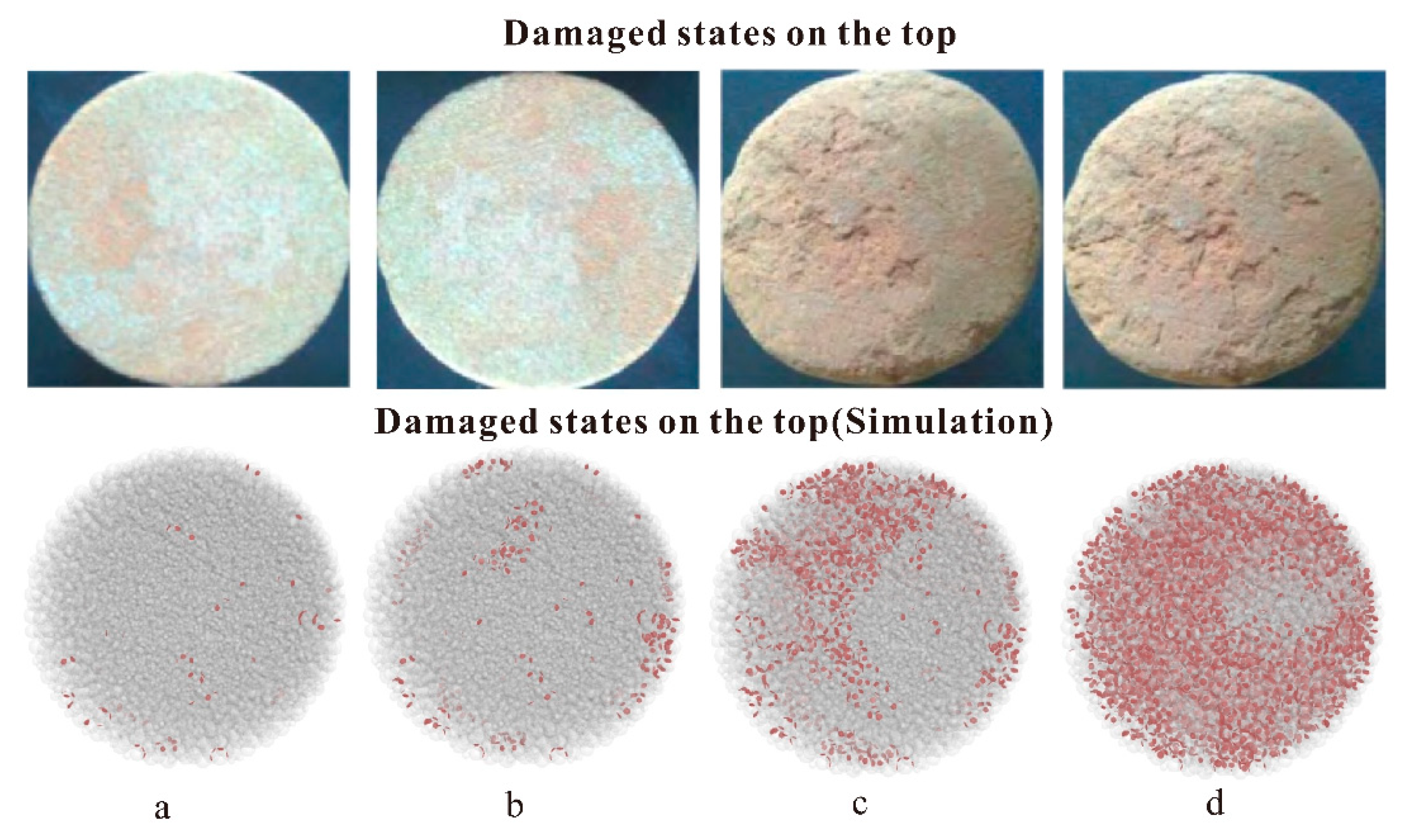
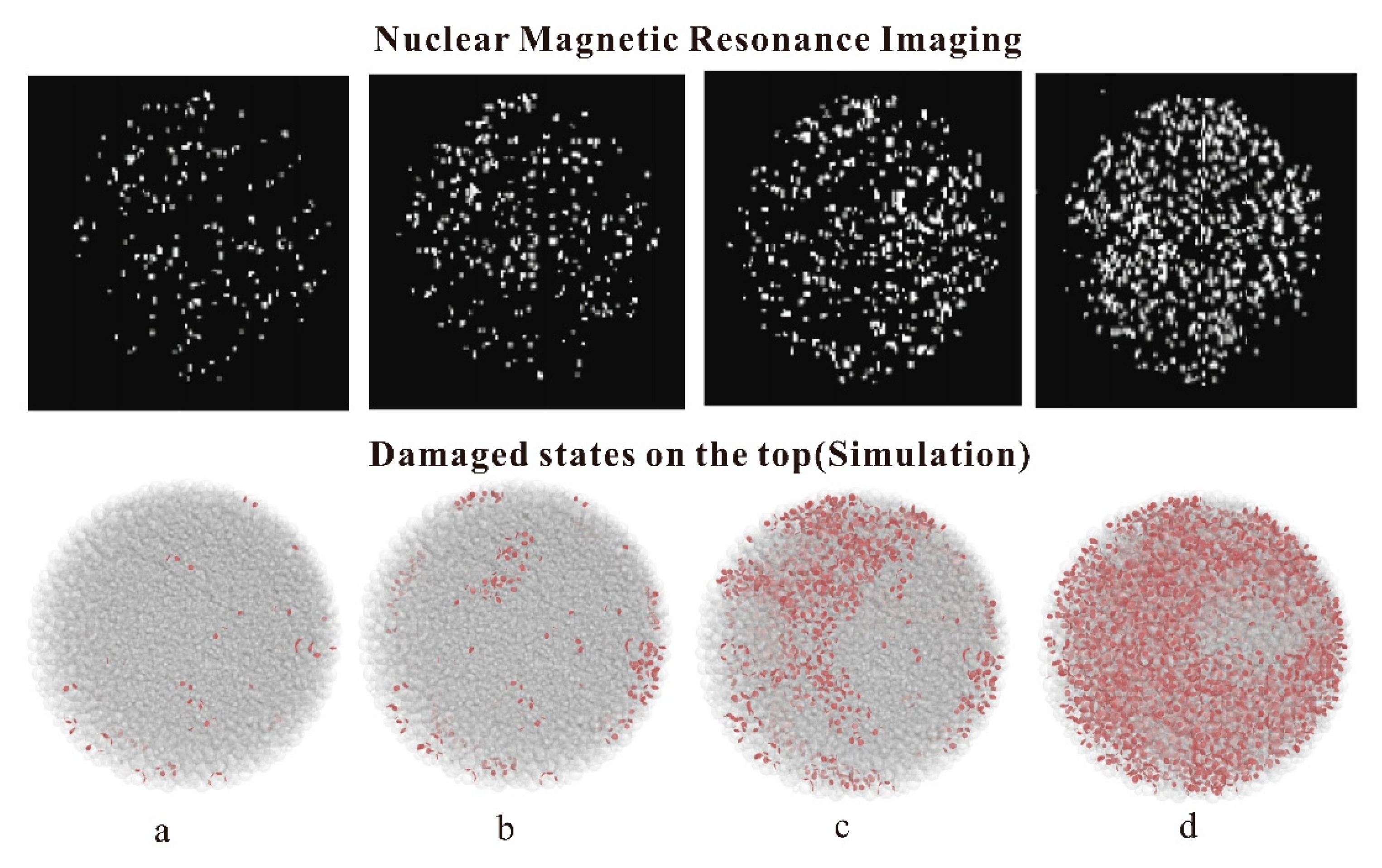


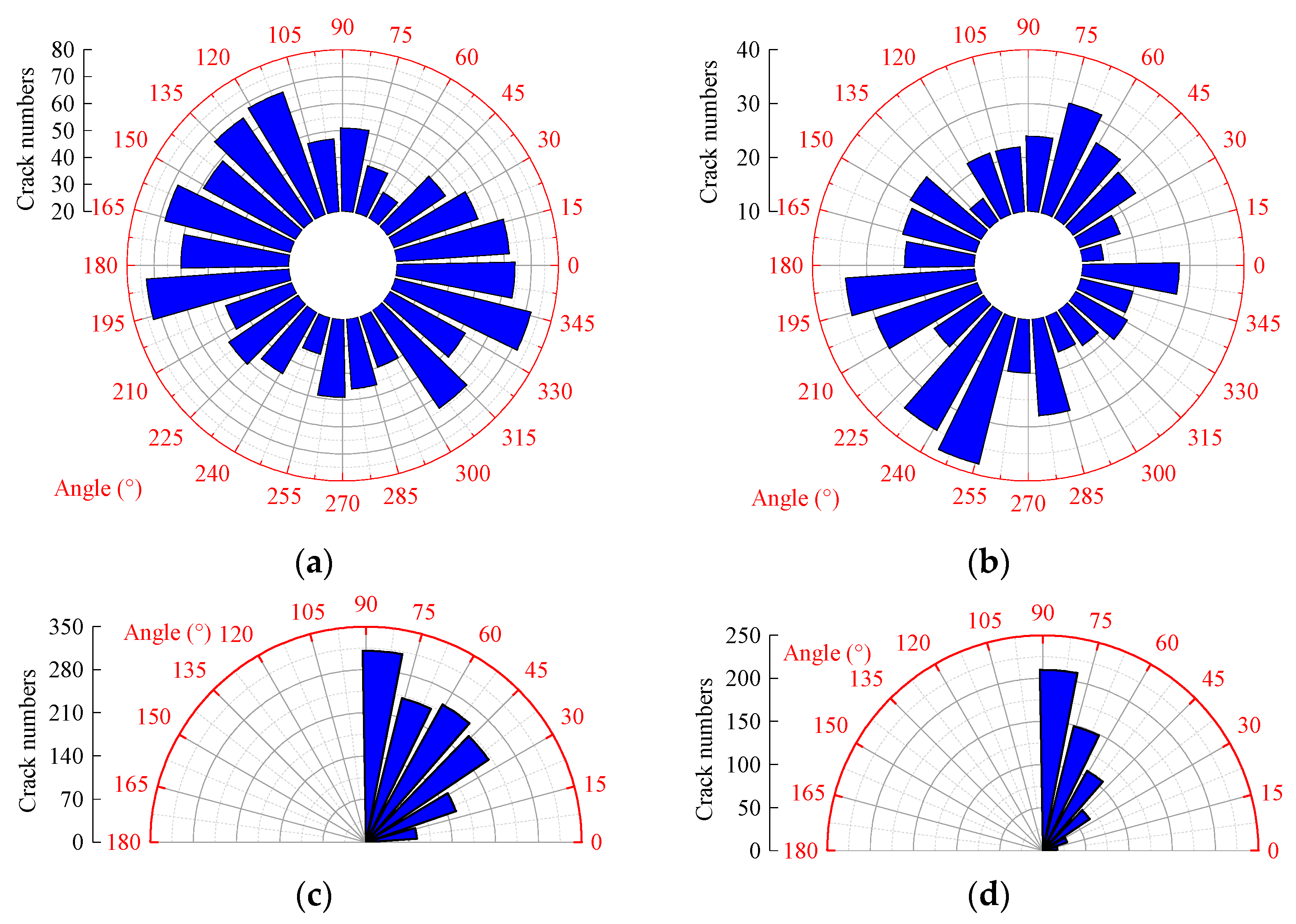
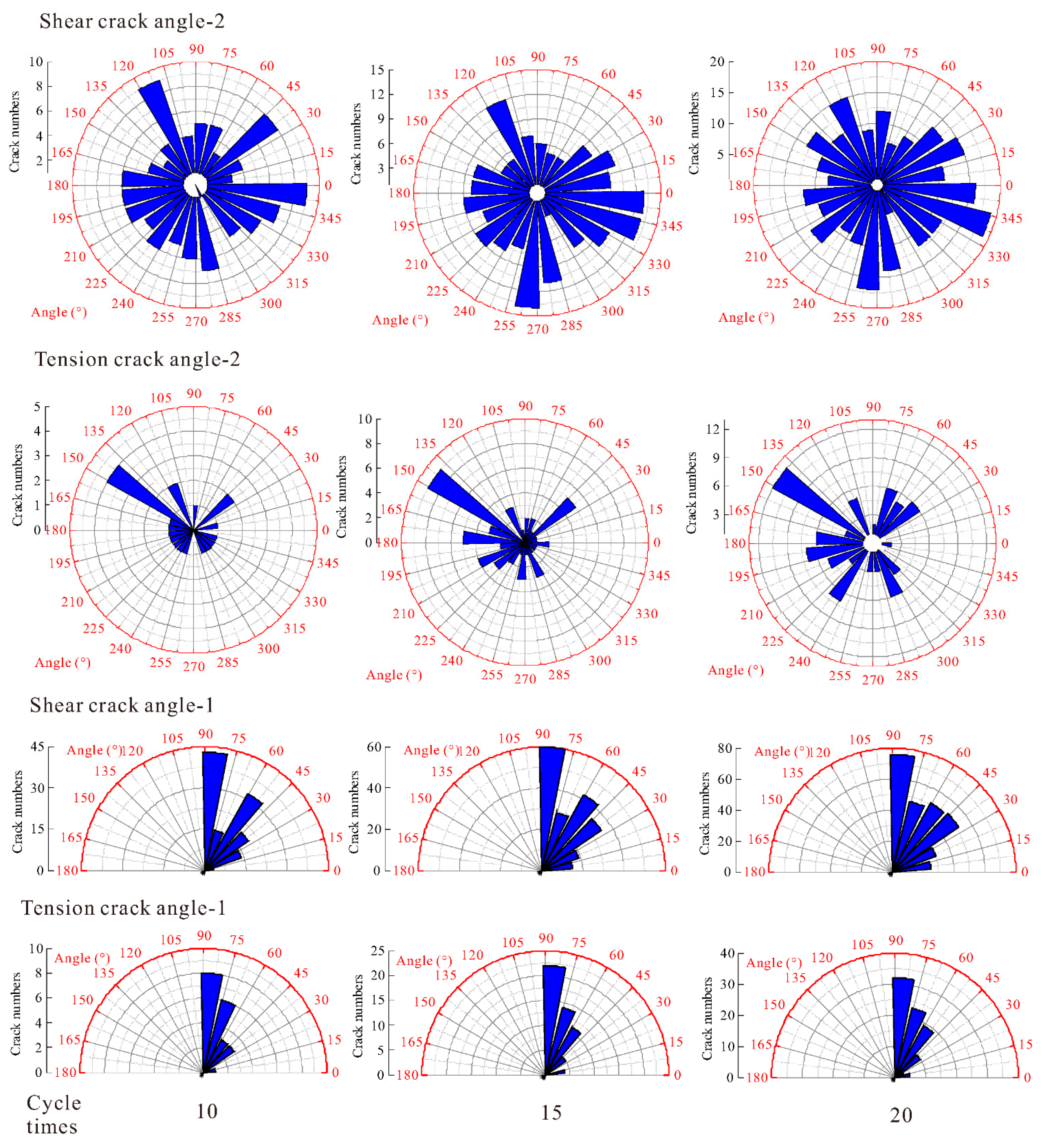


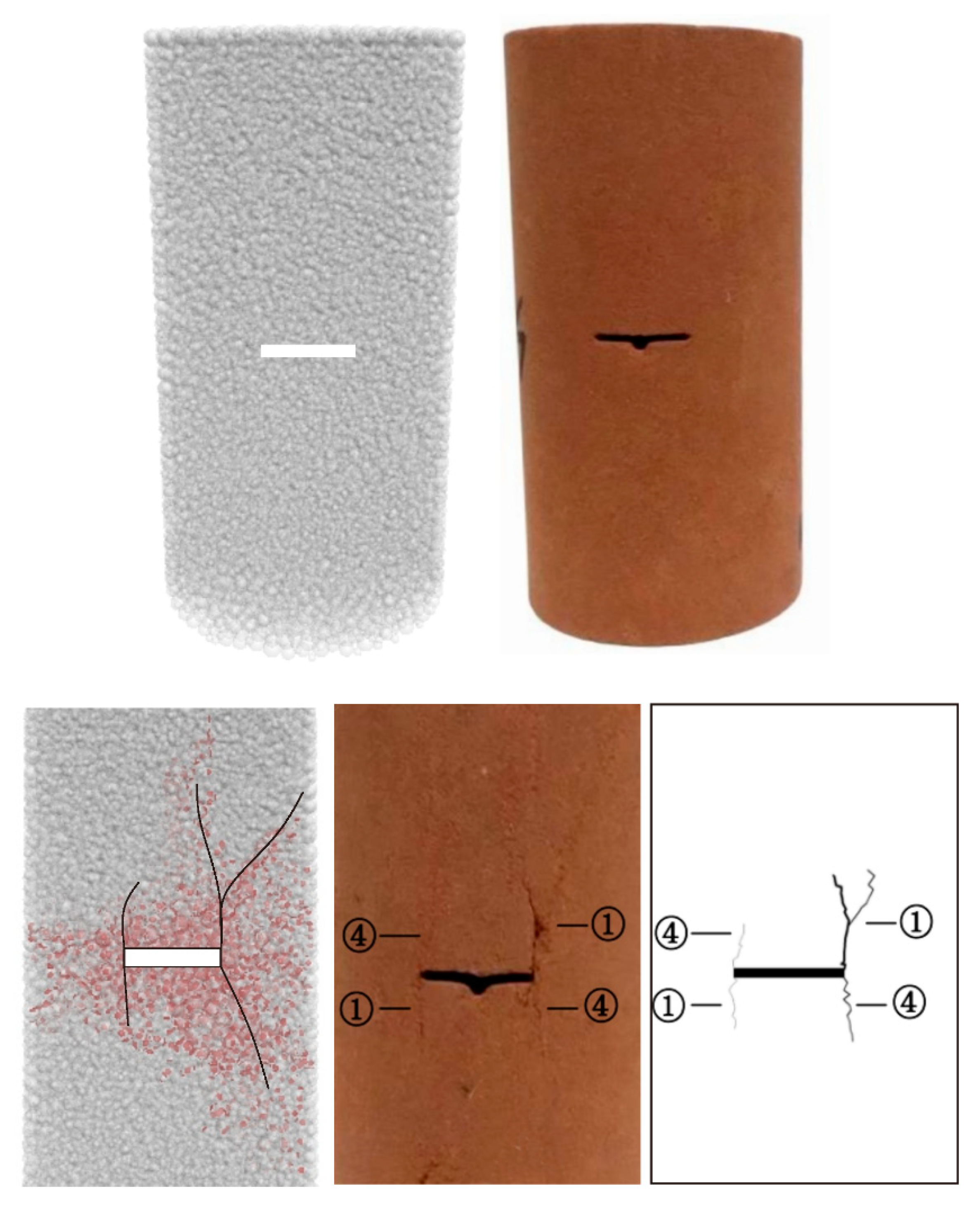


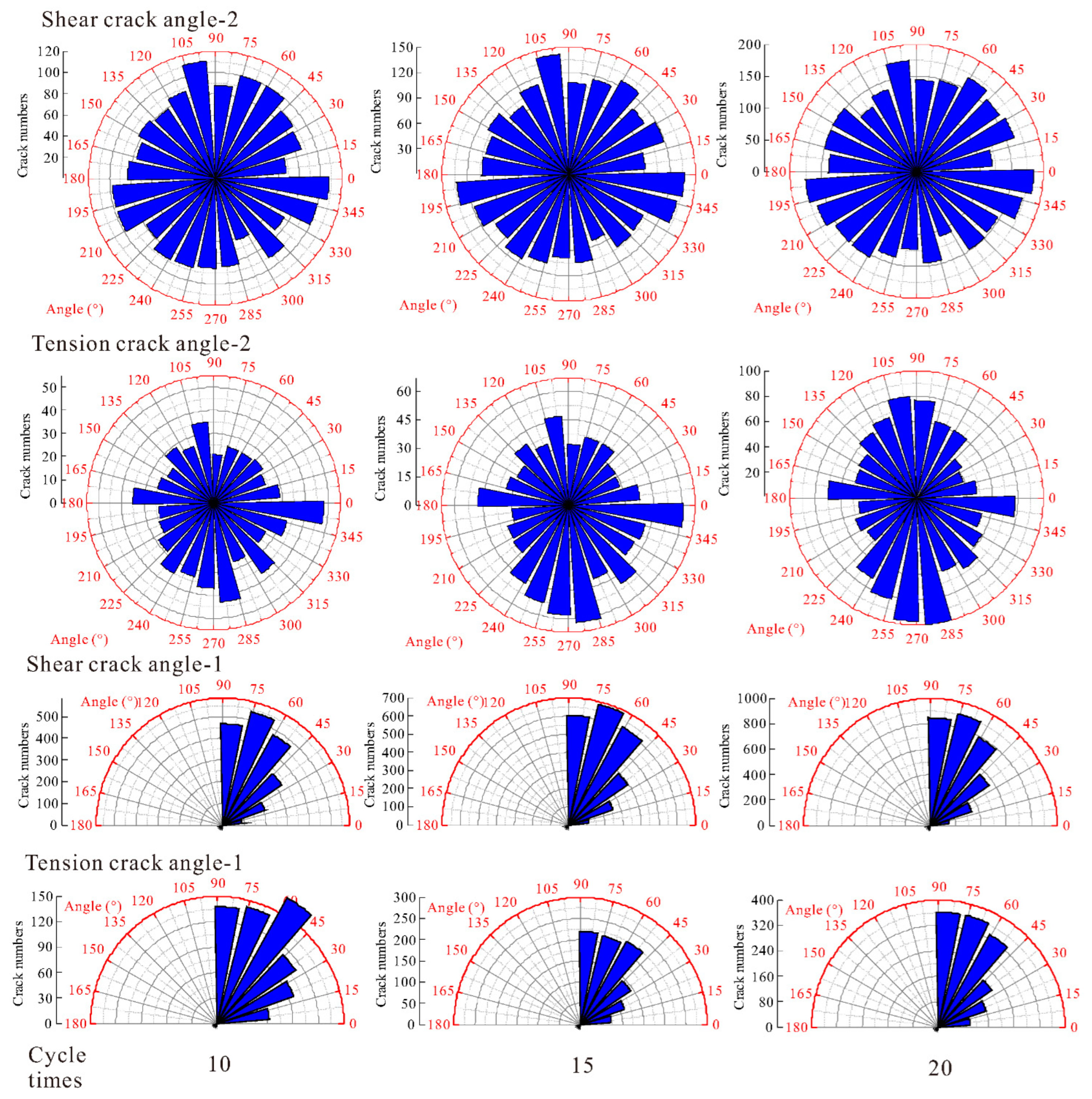
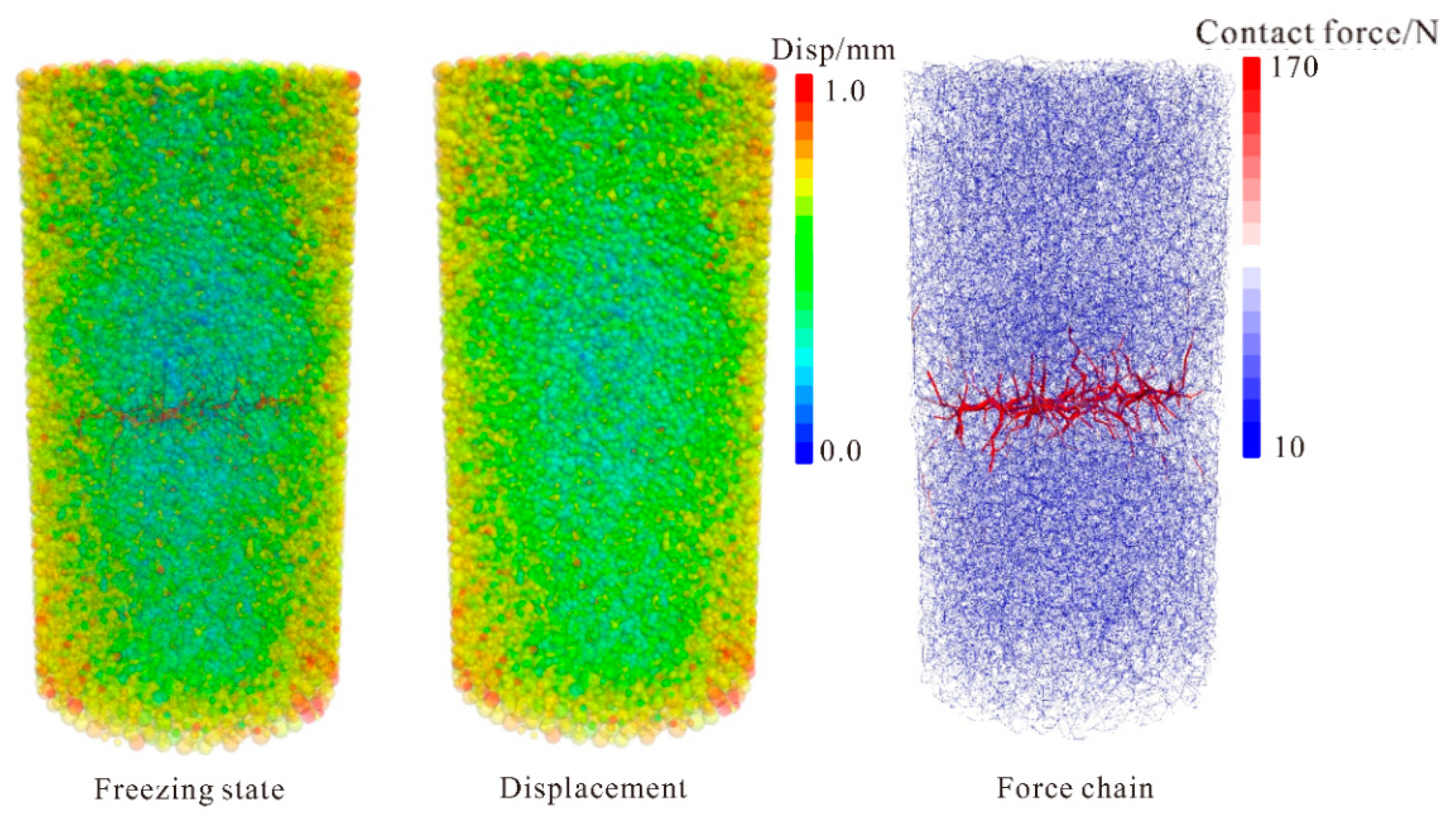

| Parameters | Value |
|---|---|
| PBM tensile strength (MPa) | 10 |
| PBM cohesion strength (MPa) | 18.8 |
| PBM modulus (GPa) | 5.2 |
| PBM friction (°) | 20 |
| Ratio of normal to shear stiffness of parallel-bond | 1.2 |
| Particle friction coefficient | 0.57 |
| Density of particle (kg/m3) | 2600 |
| Mean particle radius (mm) | 1.2 |
Publisher’s Note: MDPI stays neutral with regard to jurisdictional claims in published maps and institutional affiliations. |
© 2022 by the authors. Licensee MDPI, Basel, Switzerland. This article is an open access article distributed under the terms and conditions of the Creative Commons Attribution (CC BY) license (https://creativecommons.org/licenses/by/4.0/).
Share and Cite
Xia, C.; Liu, Z.; Zhou, C. Strength Deterioration Model of Soft Rock Considering Mesoscopic Bonding–Expansion Coupling Mechanism under Freeze–Thaw Cycles. Sustainability 2022, 14, 11766. https://doi.org/10.3390/su141811766
Xia C, Liu Z, Zhou C. Strength Deterioration Model of Soft Rock Considering Mesoscopic Bonding–Expansion Coupling Mechanism under Freeze–Thaw Cycles. Sustainability. 2022; 14(18):11766. https://doi.org/10.3390/su141811766
Chicago/Turabian StyleXia, Chang, Zhen Liu, and Cuiying Zhou. 2022. "Strength Deterioration Model of Soft Rock Considering Mesoscopic Bonding–Expansion Coupling Mechanism under Freeze–Thaw Cycles" Sustainability 14, no. 18: 11766. https://doi.org/10.3390/su141811766
APA StyleXia, C., Liu, Z., & Zhou, C. (2022). Strength Deterioration Model of Soft Rock Considering Mesoscopic Bonding–Expansion Coupling Mechanism under Freeze–Thaw Cycles. Sustainability, 14(18), 11766. https://doi.org/10.3390/su141811766






